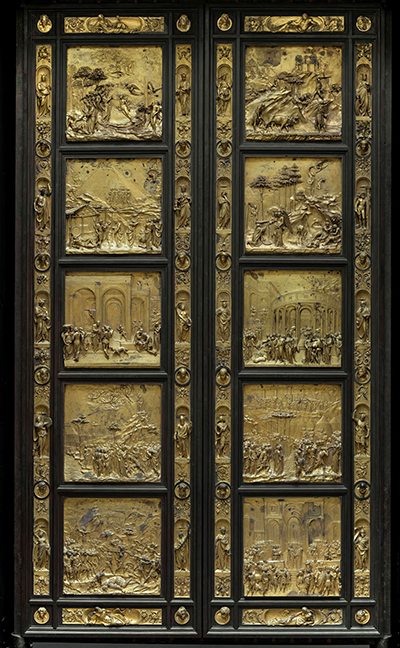Lorenzo Ghiberti will always be most famous for creating the bronze doors of the Baptistery of Florence, nicknamed by Michelangelo as the Gates of Paradise, but this biography outlines his path from prodigy to respected master
Goldsmith apprenticeships were common routes into the artistic industry during the early Renaissance, a path also taken by two of his pupils, Donatello and Filippo Brunelleschi. Lorenzo's training came directly from his father, Bartoluccio, who was already well respected in this field.
The budding artist spent his teens learning the techniques of smithery before stepping out from his father's shadow to start to begin building his own reputation. His apprenticeship at the Silk and Gold Guild would continue to expand his technical knowledge and he would eventually reach the title of guild master goldsmith. Ghiberti was 20 at this point and immediately moved to Rimini as a result of the plague which was enveloping Florence at that time.
The city of Florence, though, remained at the centre of the Italian Renaissance and his life would continue to revolve around this location for years to come. There was also great wealth in the republic, too, which meant that donors were easier to find that elsewhere in the Papal States.
Whilst in Rimini Lorenzo Ghiberti would develop some skills as a painter, contributing to some frescoes in Carlo I Malatesta's residence. This was right at the start of the 15th century and he was still many years from reaching his peak as an artist.
The artist would then embark on a series of commissions that would each take many years to complete. Lorenzo Ghiberti's career ouevre as a result oozes much more quality than quantity, though there is a possibility than some other work may have been lost in the years that have passed since.
The real breakthrough for this sculptor's career was in winning a commission for two bronze doors for the Baptistery of Florence. This prestigious project was fought for competitvely by several artists, including the likes of Filippo Brunelleschi and Jacopo della Quercia who went on to become household names themselves. The artist spent considerable time in demonstrating his creative talents and technical mastery through some example pieces made specifically for this application.
The Arte di Calimala (Cloth Importers Guild) awarded him the work in 1401 and from that point onwards he was never short of opportunities. As with many forms of self-employment, one high profile project delivered successfully can lead to many new interested clients.
Despite having built up a studio of several highly skilled assistants it was still necessary for Lorenzo Ghiberti to take well over twenty years to complete the project, finally finished in 1424. Each of the paired doors featured individually framed scenes of great beauty, all impressive artworks on their own. Put together, it astounded the Arte de Calimala and made them hire the artist again for another set of doors.
An additional reason for why the doors took quite so long was because Ghiberti was also sidetracked by several other projects. He put together a set of designs for stained-glass windows within the Cathedral of Florence and was also part of the planning team discussing the future architectural direction of this famous building. His versatility seemed endless.
Side projects continued, with 1412 marking the arrival of a commission for a large bronze statue of Saint John the Baptist. This iconic figure has been portrayed by countless Renaissance artists, be it in sculpture, painting, drawing or etching. This piece took around four years and was another example of how his assistants would take his guidance in completing the less significant areas of the final piece.
The other members of his studio may have learnt much from this master, but he also found himself picking up ideas and technical points from them as well as part of their normal process of collaboration and exchange. Many of them would forge successful careers of their own, joining their tutor on the cutting edge of the Renaissance.
Ghilberti passed away in Florence, aged 77, on December the 1st, 1455.




